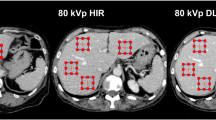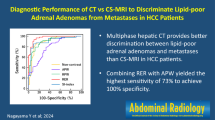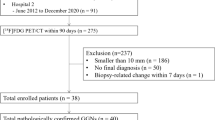Abstract
Objectives
To explore the value of dual-energy CT (DECT) for differentiating benign sinonasal lesions from malignant ones, and to compare this finding with simulated single-energy CT (SECT), conventional MRI (cMRI), and diffusion-weighted imaging (DWI).
Methods
Patients with sinonasal lesions (38 benign and 34 malignant) who were confirmed by histopathology underwent DECT, cMRI, and DWI. DECT-derived parameters (iodine concentration (IC), effective atomic number (Eff-Z), 40–180 keV (20-keV interval), virtual non-enhancement (VNC), slope (k), and linear-mixed 0.3 (Mix-0.3)), DECT morphological features, cMRI characteristics, and ADC value of benign and malignant tumors were compared using t test or chi-square test. Receiver operating characteristic (ROC) curve was performed to evaluate the diagnostic performance, and the area under the ROC curve (AUC) was compared using the Z test to select the optimal diagnostic approach.
Results
Significantly higher DECT-derived single parameters (IC, Eff-Z, 40 keV, 60 keV, 80 keV, slope (k), Mix-0.3) were found in malignant lesions than those of benign sinonasal lesions (all p < 0.004, Bonferroni correction). Combined quantitative parameters (IC, Eff-Z, 40 keV, 60 keV, 80 keV, slope (k)) can improve the diagnostic efficiency for discriminating these two entities. Combination of DECT quantitative parameters and morphological features can further improve the overall diagnostic performance, with AUC, sensitivity, specificity, and accuracy of 0.935, 96.67%, 90.00%, and 93.52%. Moreover, the AUC of DECT was higher than those of Mix-0.3 (simulated SECT), cMRI, DWI, and cMRI+DWI.
Conclusions
Compared with simulated SECT, cMRI, and DWI, DECT appears to be a more accurate imaging technique for differentiating benign from malignant sinonasal lesions.
Key Points
• DE can differentiate benign sinonasal lesions from malignant ones based on DECT-derived qualitative parameters.
• DECT appears to be more accurate in the diagnosis of sinonasal lesions when compared with simulated SECT, cMRI, and DWI.




Similar content being viewed by others
Abbreviations
- ADC:
-
Apparent diffusion coefficient
- AUC:
-
Area under the curve
- CI:
-
Confidence interval
- cMRI:
-
Conventional MRI
- CT:
-
Computed tomography
- DECT:
-
Dual-energy CT
- DWI:
-
Diffusion-weighted imaging
- Eff-Z:
-
Effective atomic number
- FOV:
-
Field of view
- IC:
-
Iodine concentration
- ICC:
-
Intraclass correlation coefficient
- Mix-0.3:
-
Linear-mixed 0.3 images
- MRI:
-
Magnetic resonance imaging
- NPV:
-
Negative predictive value
- PPV:
-
Positive predictive value
- ROC:
-
Receiver operating characteristic
- ROIs:
-
Regions of interest
- SECT:
-
Single-energy CT
- T1WI:
-
T1-weighted imaging
- T2WI:
-
T2-weighted imaging
- TE:
-
Echo time
- TR:
-
Repetition time
- VNC:
-
Virtual non-enhancement
References
Slootweg PJ, Ferlito A, Cardesa A et al (2013) Sinonasal tumors: a clinicopathologic update of selected tumors. Eur Arch Oto-Rhino-L 270:5–20
Xiao Z, Tang Z, Qiang J et al (2018) Intravoxel incoherent motion MR imaging in the differentiation of benign and malignant sinonasal lesions: comparison with conventional diffusion-weighted MR imaging. AJNR Am J Neuroradiol 39:538–546
Bossi P, Farina D, Gatta G, Lombardi D, Nicolai P, Orlandi E (2016) Paranasal sinus cancer. Crit Rev Oncol Hematol 98:45–61
Goo HW, Goo JM (2017) Dual-energy CT: new horizon in medical imaging. Korean J Radiol 18:555
Madani G, Beale TJ, Lund VJ (2009) Imaging of sinonasal tumors. Semin Ultrasound CT 30:25–38
Maroldi R, Ravanelli M, Borghesi A (2008) Farina D. Paranasal sinus imaging. Eur J Radiol 66:372–386
Jeon TY, Kim HJ, Chung SK et al (2008) Sinonasal inverted papilloma: value of convoluted cerebriform pattern on MR imaging. AJNR Am J Neuroradiol 29:1556–1560
Wang X, Yan F, Hao H, Wu J, Chen Q, Xian J (2015) Improved performance in differentiating benign from malignant sinonasal tumors using diffusion-weighted combined with dynamic contrast-enhanced magnetic resonance imaging. Chin Med J 128:586–592
Xiao Z, Tang Z, Zhang J et al (2019) Whole-tumor histogram analysis of monoexponential and advanced diffusion-weighted imaging for sinonasal malignant tumors: correlations with histopathologic features. J Magn Reson Imaging 51:273–285
El-Gerby K, El-Anwar M (2017) Differentiating benign from malignant sinonasal lesions: feasibility of diffusion weighted MRI. Int Arch Otorhinolaryngol 21:358–365
Jiang JX, Tang ZH, Zhong YF, Qiang JW (2017) Diffusion kurtosis imaging for differentiating between the benign and malignant sinonasal lesions. J Magn Reson Imaging 45:1446–1454
Su SY, Kupferman ME, DeMonte F, Levine NB, Raza SM, Hanna EY (2014) Endoscopic resection of sinonasal cancers. Curr Oncol Rep 16:369
Roele ED, Timmer VCML, Vaassen LAA, van Kroonenburgh AMJL, Postma AA (2017) Dual-energy CT in head and neck imaging. Curr Radiol Rep 5:19
Schmid-Bindert G, Henzler T, Chu TQ et al (2012) Functional imaging of lung cancer using dual energy CT: how does iodine related attenuation correlate with standardized uptake value of 18FDG-PET-CT? Eur Radiol 22:93–103
Pelgrim GJ, van Hamersvelt RW, Willemink MJ et al (2017) Accuracy of iodine quantification using dual energy CT in latest generation dual source and dual layer CT. Eur Radiol 27:3904–3912
Koonce JD, Vliegenthart R, Schoepf UJ et al (2014) Accuracy of dual-energy computed tomography for the measurement of iodine concentration using cardiac CT protocols: validation in a phantom model. Eur Radiol 24:512–518
Wu J, Lv Y, Wang N et al (2019) The value of single-source dual-energy CT imaging for discriminating microsatellite instability from microsatellite stability human colorectal cancer. Eur Radiol 29:3782–3790
Mileto A, Allen BC, Pietryga JA et al (2017) Characterization of incidental renal mass with dual-energy CT: diagnostic accuracy of effective atomic number maps for discriminating nonenhancing cysts from enhancing masses. AJR Am J Roentgenol 209:W221–W230
Forghani R (2019) An update on advanced dual-energy CT for head and neck cancer imaging. Expert Rev Anticancer Ther 19:633–644
Li M, Zheng X, Li J et al (2012) Dual-energy computed tomography imaging of thyroid nodule specimens: comparison with pathologic findings. Invest Radiol 47:58–64
Yamauchi H, Buehler M, Goodsitt MM, Keshavarzi N, Srinivasan A (2016) Dual-energy CT-based differentiation of benign posttreatment changes from primary or recurrent malignancy of the head and neck: comparison of spectral Hounsfield units at 40 and 70 keV and iodine concentration. AJR Am J Roentgenol 206:580–587
Tawfik AM, Razek AA, Kerl JM, Nour-Eldin NE, Bauer R, Vogl TJ (2014) Comparison of dual-energy CT-derived iodine content and iodine overlay of normal, inflammatory and metastatic squamous cell carcinoma cervical lymph nodes. Eur Radiol 24:574–580
Koo TK, Li MY (2016) A guideline of selecting and reporting intraclass correlation coefficients for reliability research. J Chirop Med 15:155–163
Landis JR, Koch GG (1977) The measurement of observer agreement for categorical data. Biometrics 33:159–174
Bahig H, Lapointe A, Bedwani S et al (2019) Dual-energy computed tomography for prediction of loco-regional recurrence after radiotherapy in larynx and hypopharynx squamous cell carcinoma. Eur J Radiol 110:1–6
Jiang J, Xiao Z, Tang Z, Zhong Y, Qiang J (2018) Differentiating between benign and malignant sinonasal lesions using dynamic contrast-enhanced MRI and intravoxel incoherent motion. Eur J Radiol 98:7–13
Valente G, Mamo C, Bena A et al (2006) Prognostic significance of microvessel density and vascular endothelial growth factor expression in sinonasal carcinomas. Hum Pathol 37:391–400
Ju Y, Liu A, Dong Y et al (2015) The value of nonenhanced single-source dual-energy CT for differentiating metastases from adenoma in adrenal glands. Acad Radiol 22:834–839
Forghani R, Kelly H, Yu E et al (2017) Low-energy virtual monochromatic dual-energy computed tomography images for the evaluation of head and neck squamous cell carcinoma: a study of tumor visibility compared with single-energy computed tomography and user acceptance. J Comput Assist Tomogr 41:565–571
Bodanapally UK, Dreizin D, Issa G, Archer-Arroyo KL, Sudini K, Fleiter TR (2017) Dual-energy CT in enhancing subdural effusions that masquerade as subdural hematomas: diagnosis with virtual high-monochromatic (190-keV) images. AJNR Am J Neuroradiol 38:1946–1952
Zhang Y, Cheng J, Hua X et al (2016) Can spectral CT imaging improve the differentiation between malignant and benign solitary pulmonary nodules? PLoS One 11:e147537
Kim JE, Kim HO, Bae K, Cho JM, Choi HC, Choi DS (2017) Differentiation of small intrahepatic mass-forming cholangiocarcinoma from small liver abscess by dual source dual-energy CT quantitative parameters. Eur J Radiol 92:145–152
Furuya M, Yonemitsu Y (2008) Cancer neovascularization and proinflammatory microenvironments. Curr Cancer Drug Targets 8:253–265
Jain RK (2005) Normalization of tumor vasculature: an emerging concept in antiangiogenic therapy. Science 307:58–62
Sumi M, Nakamura T (2013) Head and neck tumors: assessment of perfusion-related parameters and diffusion coefficients based on the intravoxel incoherent motion model. AJNR Am J Neuroradiol 34:410–416
Forghani R, De Man B, Gupta R (2017) Dual-energy computed tomography physical principles, approaches to scanning, physical principles, approaches to scanning, usage, and implementation: Part 2. Neuroimaging Clin N Am 27:385–400
Marin D, Boll DT, Mileto A, Nelson RC (2014) State of the art: dual-energy CT of the abdomen. Radiology 271:327–342
Koeller KK (2016) Radiologic features of sinonasal tumors. Head Neck Pathol 10:1–12
Sasaki M, Eida S, Sumi M, Nakamura T (2011) Apparent diffusion coefficient mapping for sinonasal diseases: differentiation of benign and malignant lesions. AJNR Am J Neuroradiol 32:1100–1106
White ML, Zhang Y, Robinson RA (2006) Evaluating tumors and tumorlike lesions of the nasal cavity, the paranasal sinuses, and the adjacent skull base with diffusion-weighted MRI. J Comput Assist Tomogr 30:490–495
Wang F, Sha Y, Zhao M et al (2017) High-resolution diffusion-weighted imaging improves the diagnostic accuracy of dynamic contrast-enhanced sinonasal magnetic resonance imaging. J Comput Assist Tomogr 41:199–205
Aribandi M, McCoy VA, Bazan CR (2007) Imaging features of invasive and noninvasive fungal sinusitis: a review. Radiographics 27:1283–1296
Hagspiel KD, Flors L, Housseini AM et al (2012) Pulmonary blood volume imaging with dual-energy computed tomography: spectrum of findings. Clin Radiol 67:69–77
Funding
This work was supported by the Grant of Science and Technology Commission of Shanghai Municipality (No. 17411962100).
Author information
Authors and Affiliations
Corresponding author
Ethics declarations
Guarantor
The scientific guarantor of this publication is Prof. Zuohua Tang, MD, PhD, Eye and ENT Hospital of Shanghai Medical School, Fudan University.
Conflict of interest
The authors of this manuscript declare no relationships with any companies whose products or services may be related to the subject matter of the article.
Statistics and biometry
No complex statistical methods were necessary for this paper.
Informed consent
Written informed consent was waived by the Institutional Review Board.
Ethical approval
Institutional Review Board approval was obtained.
Methodology
• retrospective
• diagnostic or prognostic study
• performed at one institution
Additional information
Publisher’s note
Springer Nature remains neutral with regard to jurisdictional claims in published maps and institutional affiliations.
Rights and permissions
About this article
Cite this article
Wang, P., Tang, Z., Xiao, Z. et al. Dual-energy CT in differentiating benign sinonasal lesions from malignant ones: comparison with simulated single-energy CT, conventional MRI, and DWI. Eur Radiol 32, 1095–1105 (2022). https://doi.org/10.1007/s00330-021-08159-3
Received:
Revised:
Accepted:
Published:
Issue Date:
DOI: https://doi.org/10.1007/s00330-021-08159-3




